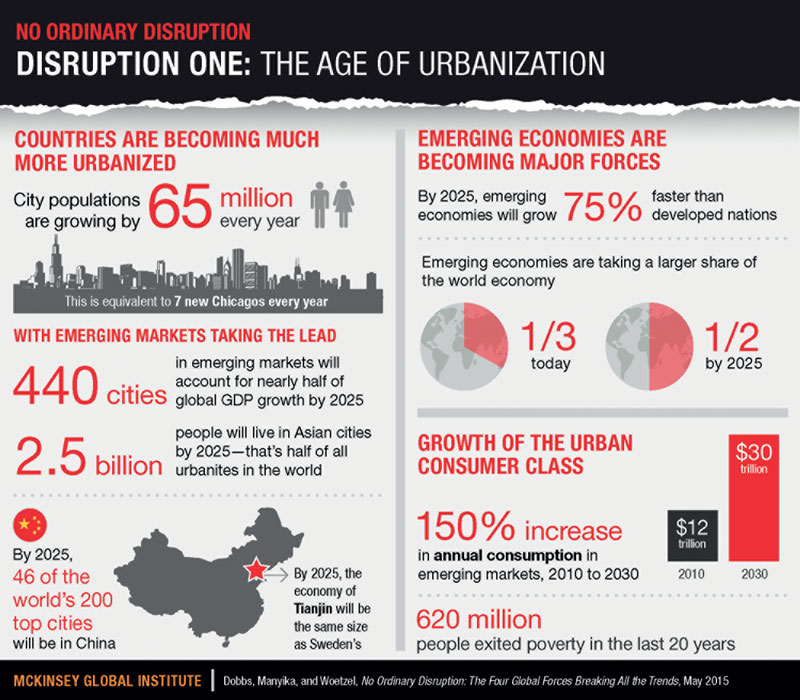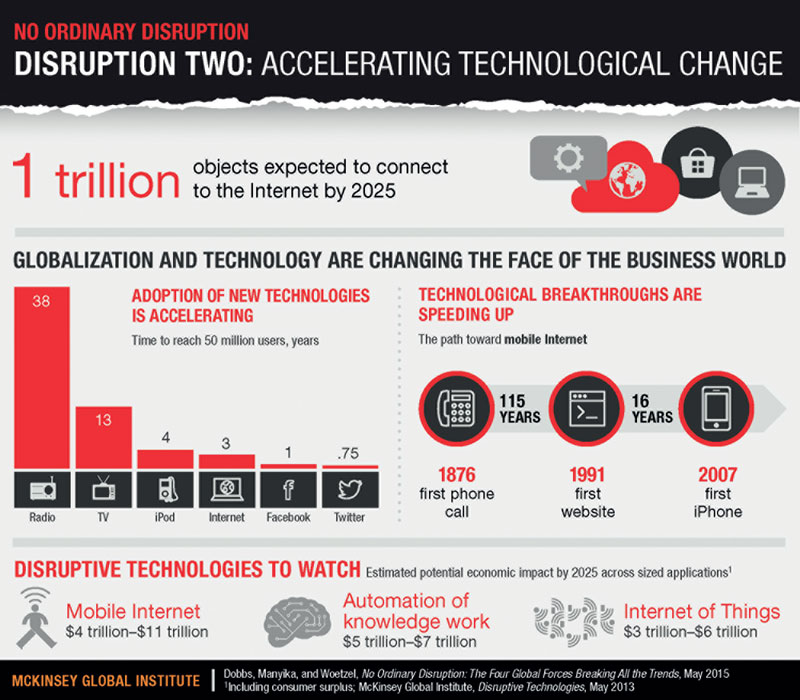No Ordinary Disruption, is an analysis by Jonathan Woetzel, Director, McKinsey Global Institute and Anu Madgavkar, Senior Fellow, McKinsey Global Institute, of how mangers need to reset their intuition as a result of the four colliding forces which are transforming the global economy: the rise of emerging markets, the accelerating impact of technology on the natural forces of market competition, an aging world population, and accelerating flows of trade, capital, people, and data.
The way our world changes often blindsides us. But the era we are living through now is, if anything, even harder to read. Four powerful forces are disrupting the global economy, upending most management intuitions and mental models. Each of these major disruptions would rank among the greatest changes the world has seen; together their impact is monumental. This is no ordinary disruption and managers need rapidly to adjust their thinking. Only those who have an acute external focus, agility, and a positive attitude to embracing change rather than resisting it will win.
The first of the four forces is the shifting locus of economic activity to emerging markets and, within them, their cities. Nearly half of global GDP growth between 2010 and 2025 will come from 440 cities in emerging markets. For example, the city of Surat accounts for about two-fifths of India’s textile production. Some of the emerging powerhouses are in the forefront of the biggest mass migration from countryside to cities in human history. In little more than a decade, India could have twice the number of urbanites that the United States has. This is part
of a significant shift now taking place in the global economy. Until recently the main focus of attention for policy-makers and business executives has been big urban areas in developed countries or the `megacities’ in developing countries. They will need to know and understand the dynamics of cities like Surat, Foshan and Porto Alegre.
Four powerful forces are disrupting the global economy, upending most management in tuitions and mental models. Each of these major disruptions would rank among the greatest changes the world has seen; together their impact is monumental. This is no ordinary disruption and managers need rapidly to adjust their thinking. Only those who have an acute external focus, agility, and a positive attitude to embracing change rather than resisting it will win.
Executives also need to brace themselves for a new wave of competitors incubated in dynamic emerging economies. Rather than focus on local rivals you know intimately, start becoming familiar with upstarts you have never heard of, based in towns and cities you have never visited, working on platforms on which you have never stepped, and deploying advantages that may be difficult to replicate. As recently as 2000, 95 percent of the Fortune Global 500 was headquartered in developed economies. By 2025, nearly half of all large companies will hail from emerging markets. Our research suggests that emerging-market companies are growing more than twice as quickly as their counterparts in developed economies. Seven out of ten of companies with sales of more than $1billion are likely to be based in emerging regions. Indicators are visible already-some Indian companies have surpassed the scale of western counterparts. Bharti Airtel has 275 million customers while America’s AT&T serves 116 million wireless customers.
Business leaders need to be more agile in the new competitive era. They need to develop skills, and they need to elevate technology to the core of strategic thinking in every business unit, using technology to disrupt their own business models. A satellite sales office instead of a new headquarters, a pop-up store instead of a big box, a food truck instead of a large restaurant, even the basic “lean” skill of continuous improvement–all are ways that companies can respond quickly to disruptions.
The second great disruption is the acceleration of technological change. Technology has always been transformative; what is different today is its sheer ubiquity and the pace of adoption of digital and mobile technologies. This disruption is also changing the nature of global competition radically–and intensifying it.
It is no longer sufficient to regard large firms as potential competitors. Start-ups with access to digital platforms can be born global–the new micromultinational–and scale up in the blink of an eye. India has dozens of such examples – Bangalore-based Portea Medical has become a world-class innovator in home healthcare delivery by using geospatial data and predictive analytics to send clinicians to the nearest homes efficiently.
The new competitive environment is only reinforced by the third disruption—accelerating and deepening interconnections through trade, capital, people, and, increasingly, information. Relatively recently, the cross-border web was a series of lines between major trading hubs in Europe and North America but, today, the web is intricate and sprawling. Cross-border fl ows between emerging markets have doubled in just ten years. More than one billion people crossed borders in 2009, over fi ve times the number in 1980. We are seeing globalisation on a scale never before witnessed.
The final force–aging–ups the ante for businesses because the risk is that demographics bear down on economic growth and erode labour pools. For the fi rst time in human history, aging could mean that the planet’s population plateaus in most of the world. The greying phenomenon in the developed economies of the West has been evident for some time, but now it is spreading to China and soon Latin America. Thirty years ago, only a small share of the global population lived in the few countries with fertility rates substantially below those needed to replace each generation–2.1 children per woman. But by 2013, about 60 percent of the world’s population lived in countries with fertility rates below the replacement rate.
India is at the heart of the four forces that are shaping our world today–urbanisation, accelerating technological change, greater trade and connectivity, and even aging (India may be a young country in terms of average across the population, but it has 100 million people over the age of 70 to deal with). These forces, which we describe in our new book No Ordinary Disruption, challenge business leaders, consumers, and policy makers to rethink many old assumptions about how the world works. For India, these trends represent significant opportunities for growth and social progress in the coming decade. They also present new challenges. To keep up with the demands of urban growth, India will need to invest $1.2 trillion in urban infrastructure, eight times what it is spending per capita now by 2030. They will also need to build 700-900 million square meters of commercial and residential real estate, 350-400 kilometers of metros and subways every year, and pave 2.5 billion square meters of roads–twenty times what it has paved in the last decade.
Business leaders need to be more agile in the new competitive era. They need to develop skills, and they need to elevate technology to the core of strategic thinking in every business unit, using technology to disrupt their own business models. A satellite sales office instead of a new headquarters, a pop-up store instead of a big box, a food truck instead of a large restaurant, even the basic “lean” skill of continuous improvement–all are ways that companies can respond quickly to disruptions.

Lastly, the successful executives of this new era will be those who are optimistic–who see opportunity as well as competitive threat. Thanks to the forces at work, the world we inhabit ten, or more years from now will be a better one. Those who understand the magnitude and the permanence of the changes that we are now witnessing, reset their intuitions accordingly, and see the opportunities will shape this new world—and they will thrive.











